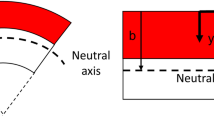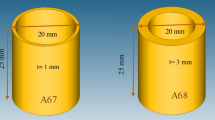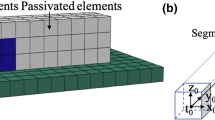Abstract
Residual stress and deformation are common issues which prevent dimensional accuracy and lead early fatigue of products by laser metal deposition process. Finite element analysis is an efficient means to estimate the temperature history and thermal stress distribution. However, it is extremely challenging to predict thermal history and stress distribution of a practical large and complex geometry if each laser pulse is taken into account as by conventional laser pulse modeling. Therefore, in this study, an efficient predictive finite element model with assumptions on the laser heat source and loading is established to study the evolution of thermal history, residual stresses, and deformations of a test coupon. The efficient predictive model, which is also called as the 2-layer by 2-layer model, simulates two layers at each laser pulse time. This model is compared with conventional laser pulse model in terms of the evolution of thermal history of selected points and residual stresses. Results show that the 2-layer by 2-layer model considerably reduces the simulation time without much compromising the accuracy of the prediction of deformation and thermal stress. In addition, test coupon is designed and fabricated to capture temperature history and observe microstructure change. It is found that microstructure presents certain correlation with cooling rate. Microstructure and residual stress of the test coupon are evaluated and found to be consistent with the prediction by proposed model. This efficient predictive model can shed light on large-scale part fabrication by laser metal deposition process in industry.













Similar content being viewed by others
Availability of data and material
Not applicable.
References
Wu AS, Brown DW, Kumar M, Gallegos GF, King WE (2014) An experimental investigation into additive manufacturing-induced residual stresses in 316L stainless steel. Metall Mater Trans A 45:6260–6270
Sochalski-Kolbus L, Payzant EA, Cornwell PA, Watkins TR, Babu SS, Dehoff RR, Lorenz M, Ovchinnikova O, Duty C (2015) Comparison of residual stresses in Inconel 718 simple parts made by electron beam melting and direct laser metal sintering. Metall Mater Trans A 46:1419–1432
An K, Yuan L, Dial L, Spinelli I, Stoica AD, Gao Y (2017) Neutron residual stress measurement and numerical modeling in a curved thin-walled structure by laser powder bed fusion additive manufacturing. Mater Des 135:122–132
Chiumenti M, Lin X, Cervera M et al (2017) Numerical simulation and experimental calibration of additive manufacturing by blown powder technology. Part I: thermal analysis. Rapid Prototyp J 23(2):448–463
Peyre P, Aubry P, Fabbro R, Neveu R, Longuet A (2008) Analytical and numerical modelling of the direct metal deposition laser process. J Phys D 41(2):025403
Sammons PM, Bristow DA, Landers RG (2013) Height dependent laser metal deposition process modeling. J Manuf Sci Eng 135(5):054501
Lu X, Lin X, Chiumenti M, Cervera M, Li JJ, Ma L, Wei L, Hu Y, Huang W (2018) Finite element analysis and experimental validation of the thermomechanical behavior in laser solid forming of Ti-6Al-4V. Addit Manuf 21:30–40
Chiumenti M, Cervera M, Salmi A, Agelet de Saracibar C, Dialami N, Matsui K (2010) Finite element modeling of multi-pass welding and shaped metal deposition processes. Comput Methods Appl Mech Eng 199(37–40):2343–2359
Marimuthu S, Clark D, Allen J, Kamara AM, Mativenga P, Li L, Scudamore R (2013) Finite element modelling of substrate thermal distortion in direct laser additive manufacture of an aero-engine component. Proc Inst Mech Eng Part C J Mech Eng Sci 227(9):1987–1999
Yang Q, Zhang P, Cheng L, Min Z, Chyu M, To AC (2016) Finite element modeling and validation of thermomechanical behavior of Ti-6Al-4V in directed energy deposition additive manufacturing. Addit Manuf 12:169–177
Denlinger ER, Heigel JC, Michaleris P (2015) Residual stress and distortion modeling of electron beam direct manufacturing Ti-6Al-4V. Proc Inst Mech Eng, Part B: J Eng Manuf 229(10):1803–1810
Wang Z, Denlinger E, Michaleris P, Stoica AD, Ma D, Beese AM (2017) Residual stress map** in Inconel 625 fabricated through additive manufacturing: method for neutron diffraction measurements to validate thermomechanical model predictions. Mater Des 113:169–177
Wang Z, Stoica AD, Ma D et al (2016) Diffraction and single-crystal elastic constants of Inconel 625 at room and elevated temperatures determined by neutron diffraction. Mater Sci Eng A 674:406–412
Li L, Zhang X, Cui W et al Temperature and residual stress distribution of FGM parts by DED process: modeling and experimental validation. Int J Adv Manuf Technol 109:451–462
Heigel JC, Michaleris P, Reutzel EW (2015) Thermo-mechanical model development and validation of directed energy deposition additive manufacturing of Ti–6Al–4V. Addit Manuf 5:9–19
Lu X, Lin X, Chiumenti M, Cervera M, Hu Y, Ji X, Liang M, Yang H, Huang W (2019) Residual stress and distortion of rectangular and S-shaped Ti-6Al-4V parts by directed energy deposition: modelling and experimental calibration. Addit Manufac 26:166–179
Ali H, Ghadbeigi H, Mumtaz K (2018) Residual stress development in selective laser-melted Ti6Al4V: a parametric thermal modelling approach. Int J Adv Manuf Technol 97:2621–2633
Zhang Z, Ge P, Yao XX, Li T, Liu WW (2020) Numerical studies of residual states and scaling effects in laser-directed energy deposition additive manufacturing. Int J Adv Manuf Technol 108(4):1233–1247
Li C, Liu JF, Fang XY, Guo YB (2017) Efficient predictive model of part distortion and residual stress in selective laser melting. Addit Manufac 17:157–168
Li L, Pan T, Zhang X, Chen Y, Cui W, Yan L, Liou F (2021) Deformations and stresses prediction of cantilever structures fabricated by selective laser melting process. Rapid Prototyp J ahead-of-print
Keller N et al (2013) Thermo-mechanical simulation of additive layer manufacturing of titanium aerospace structures. LightMAT Conf 3:5
Neugebauer F et al (2014) Simulation of selective laser melting using process specific layer based meshing, Proc. Fraunhofer direct digital manufacturing conf.(DDMC 2014). Axel Demmer, Aachen
Lei Yan, Tan Pan, Joseph W. Newkirk, Frank Liou, Eric E. Thomas, Andrew H. Bake, James B. Castle (2018) Fast prediction of thermal history in large-scale parts fabricated via a laser metal deposition process, solid freeform fabrication 2018: Proceedings of the 29th annual international.
Zaeh MF, Branner G (2010) Investigations on residual stresses and deformations in selective laser melting. Prod Eng Res Devel 4:35–45
Bayat M, Klingaa CG, Mohanty S, De Baere D, Thorborg J, Tiedje NS, Hattel JH (2020) Part-scale thermo-mechanical modelling of distortions in laser powder bed fusion–analysis of the sequential flash heating method with experimental validation. Addit Manuf 36:101508
Megahed M, Mindt H-W, N’Dri N, Duan H, Desmaison O (2016) Metal additive manufacturing process and residual stress modeling. Integrat Mater Manuf Innov 5:1–33
Peyre P, Aubry P, Fabbro R, Neveu R, Longuet A (2018) Analytical and numerical modelling of the direct metal deposition laser process. J Phys D Appl Phys 41:025403
Irwin J, Michaleris P (2016) A line heat input model for additive manufacturing. J Manuf Sci Eng 138(11):111004
ANSYS Theory Manual, Release 8.1, ANSYS Inc., USA, 2004.
Ole Sigmund (2011) Notes and exercises for the course: FEM-Heavy (41525), Technical University of Denmark, 2011.
Cao J, Gharghouri MA, Nash P (2016) Finite-element analysis and experimental validation of thermal residual stress and distortion in electron beam additive manufactured Ti-6Al-4V build plates. J Mater Process Technol 237:409–419
Setien I, Chiumenti M, Veen SVD et al (2018) Empirical methodology to determine inherent strains in additive manufacturing. Comput Math Appl
Michaleris P, Zhang L, Bhide SR et al (2006) Evaluation of 2D, 3D and applied plastic strain methods for predicting buckling welding distortion and residual stress. SciTechnol Weld Join 11(6):707–716 X. Lu et al. Additive Manufacturing 26 (2019) 166–179
**ong J, Li R, Lei Y, Chen H (2018) Heat propagation of circular thin-walled parts fabricated in additive manufacturing using gas metal arc welding. J Mater Proc Technol 251:12–19
Ding J, Colegrove P, Mehnen J, Williams S, Wang F, Almeida PS (2014) A computationally efficient finite element model of wire and arc additive manufacture. Int J Adv Manuf Technol 70(1-4):227–236
Szost BA, Terzi S, Martina F, Boisselier D, Prytuliak A, Pirling T, Hofmann M, Jarvis DJ (2016) A comparative study of additive manufacturing techniques: residual stress and microstructural analysis of CLAD and WAAM printed Ti–6Al–4V components. Mater Des 89:559–567
Cao J, Gharghouri MA, Nash P (2016) Finite-element analysis and experimental validation of thermal residual stress and distortion in electron beam additive manufactured Ti-6Al-4V build plates. J Mater Process Technol 237:409–419
Hoye N, Li HJ, Cuiuri D et al (2014) Measurement of residual stresses in titanium aerospace components formed via additive manufacturing. Mater Sci Forum 777:124–129 Trans Tech Publications
Yan L, Cui W, Newkirk JW, Liou F, Thomas EE, Baker AH, Castle JB (2018) Build strategy investigation of Ti-6Al-4V produced via a hybrid manufacturing process. JOM 70(9):1706–1713
Acknowledgements
This project was supported by National Science Foundation Grants CMMI 1625736, and the Intelligent Systems Center, Center for Aerospace Manufacturing Technologies, and Material Research Center at Missouri S&T. Their financial support is greatly appreciated.
Funding
This project was supported by National Science Foundation Grants CMMI 1625736.
Author information
Authors and Affiliations
Contributions
Lan Li: conceptualization; methodology; data curation; software; validation; visualization; writing—original draft.
Lei Yan: validation; investigation.
Frank Liou: conceptualization; methodology.
Chao Zeng: writing—review and editing.
Corresponding author
Ethics declarations
Ethics approval
Not applicable.
Consent to participate
Yes, consent to participate from all the authors.
Consent for publication
Yes, consent to publish from all the authors.
Conflict of interest
The authors declare no competing interests.
Additional information
Publisher’s note
Springer Nature remains neutral with regard to jurisdictional claims in published maps and institutional affiliations.
Rights and permissions
About this article
Cite this article
Li, L., Yan, L., Zeng, C. et al. An efficient predictive modeling for simulating part-scale residual stress in laser metal deposition process. Int J Adv Manuf Technol 114, 1819–1832 (2021). https://doi.org/10.1007/s00170-021-07005-6
Received:
Accepted:
Published:
Issue Date:
DOI: https://doi.org/10.1007/s00170-021-07005-6




